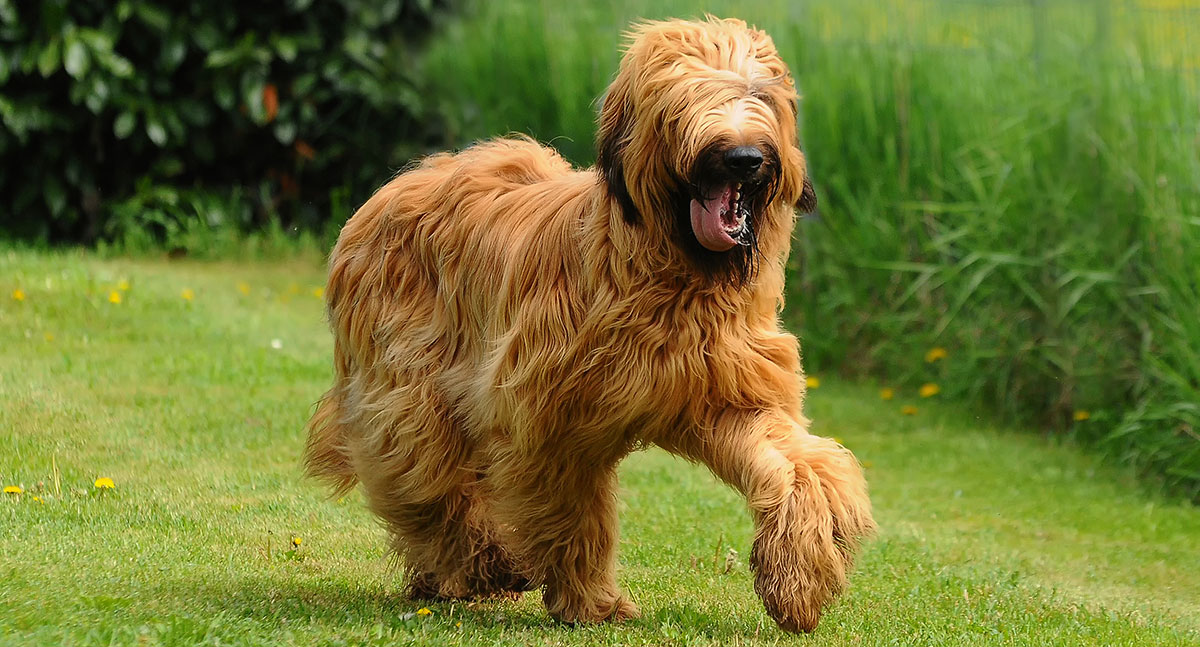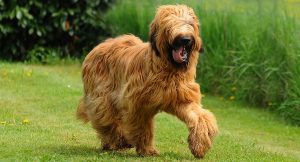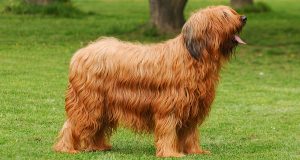
Briard – Pastoral

Image: Ricantimages/Shutterstock.com
| Name | Briard - Pastoral |
|---|---|
| Size | Medium |
| Grooming | Difficult |
| Training | Moderate |
| Exercise | At Least 2 hours a day |
| Origins | France |
The Big Hearted Furry Herder
Quick overview
If you like your dogs big & hairy with a touch of history about them then you might like to consider the Berger de Brie (to give it its French name). They are not the dog for the casual owner or anyone who lives in a house without a garden, but for the right owner, they are a dream dog. Anyway have a read and see if one fits the bill.

Image: Ricantimages/Shutterstock.com
Name: The Briard, the Berger de Brie
Size: Up to 27 inches tall
Weight: Up to 40 kilograms in weight
Grooming: Your Briard will need daily brushing
Training: The tougher end of moderate
Exercise: Roughly 2 hours per day
Lifespan: Between 10 and 12 years, maybe more
Origins: France (the Chien Berger de Brie)
Breed Type: Herding dog
A little Briard History
The Briard dog breed originated from Northern France in the areas of the pasture Lands and fields around Charlemagne. The breed was developed to help around the farms both as a cattle herder and as guard dogs in the evening. Back in the day, many farmers would keep dogs around the house even to track rats, deter vermin, and to keep the flocks safe.
The Briard is one of the best-known French breeds finding plenty of recognition in France and becoming incredibly popular around the times of Napoleon. Prior to the First World War, the Briard was one of the best-known dogs in the country. It is a noted close cousin to the Beauceron and the Barbet, both of which were dogs used by French farmers in a similar way and at a similar time. During that First World War period, they were actually used in the search for wounded soldiers after battles. To this day they are noted as being brilliant military and search and rescue dogs - although there are more commonly kept as companions. The Briard was displayed at the very first-ever friends' dog show circa the 1860s.
The Briard is perhaps best known for being long-haired and for having such a silky coat. this coat would have performed a dual function, allowing them to retrieve prey, even in the wettest and wildest conditions. This wonderfully loyal pup has a decorated history as one of France's favourite dogs. Its versatility is what makes it brilliant for both a farm and/or working or herding dog and as a faithful companion.
Fun Facts about your Briard Pup!
If you are the proud new owner of a Briard pup than you have found yourself one of many - but that doesn't make the experience any less pleasant. We researched some of the best things about owning a new Briard pup, just for you. Here are the Five Minutes Spare favourite facts about the Briard for your ears only:
- No matter where you live in the world there are multiple Briard clubs this popular dog has at least three. you can join the Briard Association, you can visit the first UK Briard website, or you can join the official British Briard Club. You can also find them in the AKC, the UKC and the UK Kennel Club.
- It is a legend about a Briard who fought a duel with a man to avenge the death of his owner.
- Napoleon Bonaparte (although he was renowned as someone who was not fond of dogs) took Briards with him on his later military campaigns.
- You will never get a White Briard they are out of tawny, black, grey, or blue - but never white.
So as you see, the Briard is more interesting than you thought! if you happen to own another of the dogs in our dog directory, don't forget that you can head on over to 5 Minutes Spare and check it out.
Do they need much exercise?
The Briard needs at least 2-hours exercise every day. This might mean two long walks or 1 long walk and a long play outdoors in the garden. This means that the Briard is an excellent dog to accompany you to work in a physical role. If you do not walk your Briard enough you will find that they're disruptive and mischievous and might well chew your furniture - so always walk your dog!
Are they hard to train?
Training of the Briard errs on the side of difficult, as they are a little headstrong making it tricky. Although they're friendly and patient dogs they do tend to be a little more stubborn then what you are perhaps used to. This is because they were once a working dog and would have been left in the fields so operating independently most of the time. This trait is difficult to breed out of them.
How often do I need to groom my Briard?
The Briard is not one of the hypoallergenic dog breeds and from the pictures, you can see why! They have a long double coat which will need to be brushed at least once every two days to keep it in order and preferably every day and you will need to trim their nails once they get too long. Although this can be avoided with plenty of pavement walks. You will also need to brush their teeth at least once a week but the more often the better. Consider your dog's teeth needs to be similar to that of a child - despite you the dog eating less sugar!

Your Berger de Brie won't look like this without daily grooming!
Image: TrapezaStudio/Shutterstock.com
Are they a healthy dog breed?
The Briard has a fairly lengthy history going all the way back down through generations in France. Unfortunately, a dog breed doesn't get to be this old without having picked up a few genetic diseases and conditions along the way. Briards are known to suffer from hip dysplasia, and certain types of blindness including cataracts, corneal dystrophy, and retinal folds. A reputable breeder will be able to let you know if there is a family history of any f these conditions. They also suffer from certain skin conditions & underactive thyroid gland conditions (hypothyroidism). Don't let this put you off though as most conditions are treatable nowadays.
Where can I buy a Briard dog?
You should buy your Briard from a registered breeder, which you should be able to find through your local kennel club website. The breeders recorded by your Kennel Club are those which keep a familial history of your pet and can therefore advise you of any health defect and their ancestry. Be vigilant when you buy your new Briard puppy that you are not using a puppy farmer. If the breeder cannot introduce you to one or both of your puppy’s parents, it is possible you have come across a puppy farmer and you should report them to the police.
Got Another Five Minutes Spare?
Are you still looking for some break time Reading? you can find all sorts of information on all sorts of topics over at 5-minutes Spare. Even if the Briard isn't the right dog for you we have a full directory detailing everything from the Affenpinscher to the Beagle. everything is possible can you have 5 Minutes Spare.